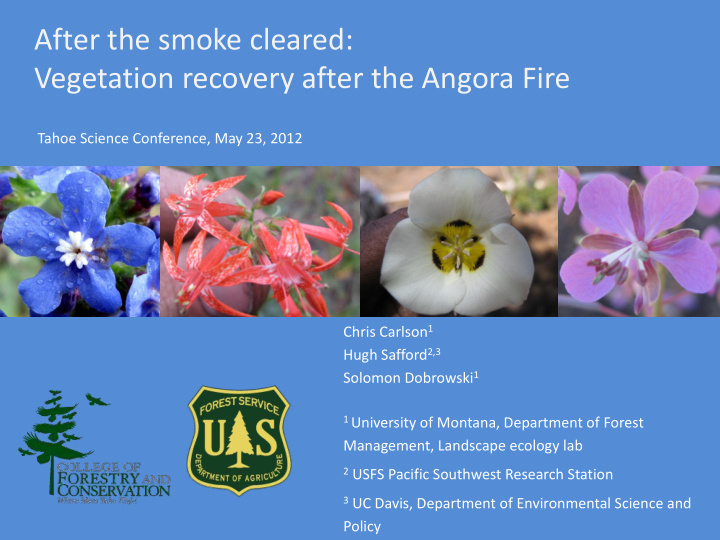



After the smoke cleared: Vegetation recovery after the Angora Fire Tahoe Science Conference, May 23, 2012 Chris Carlson 1 Hugh Safford 2,3 Solomon Dobrowski 1 1 University of Montana, Department of Forest Management, Landscape ecology lab 2 USFS Pacific Southwest Research Station 3 UC Davis, Department of Environmental Science and Policy
Research Questions: • How did wildfire affect vegetation? – Natural and management related variation in fire severity – Changes in carbon storage • How has vegetation responded? – Fuel accumulation – Tree regeneration – Understory recovery • Long-term implications? – Vegetation recovery after historical fires in area – Carbon recovery
Background – Site Description • Mixed conifer forest + chaparral – Jeffrey pine, White fir, Incense cedar – Red fir series on upper slopes, ridges – Quaking aspen, willow, lodgepole along creeks/seeps – Montane chaparral – Influence of both East side and West slope vegetation – Mix of quaternary, granitic and metamorphic substrates • History of logging, grazing, development, fire suppression, fuel reduction treatments, post-fire management
History of vegetation change: Last recorded wildfire: 1882 Comstock logging in 1890’s Grazing through 1950s Fuel reduction treatments, 1998-2007 Wildfire: 2007 Post-fire management: On-going • 1939 • 2004 Historical Fire: • 2007 1882 • 2010
Methods – Data Collection • 86 1/5 th acre CSE plots (see left) • 200+ 1/70 th acre regeneration plots (see next page) • Collected detailed tree, fuels, species composition at Common Stand exam plots in 2008-2010, and regeneration data in 2008-2011 • Common stand exam plots (400m spacing) Surveyed 3 years (and in 2012) n=68 burned, 18 unburned plots 13 plots treated for fuels 2000-2007 26 nearby plots not treated for fuels 29 “other’ burned plots • Regeneration plots (200m spacing) n=204 plots surveyed all 4 years
Methods – Data Collection Fire severity and Regeneration Plot Map • Angora Fire of 2007 • June 24, relatively early season • High winds, dry conditions, >95 th %ile fire danger for the date • Burned 2000 acres (2/3 of total area) in first 24 hours • High Severity fire across ~1/2 of burn area
Results: How did wildfire affect vegetation? – Naturally occurring variation in fire severity And skewed towards high mortality, variation in mortality Mortality rates correlated with pre-fire across spatial and temporal stem density scales p < 0.001, r^2 = 0.311 Percent Mortality Percent Mortality 55 150 405 1100 Trees per acre (log scale) Fire severity 1/2 3 4 5 % plots = 29% 19% 22% 29%
Results: How did wildfire affect vegetation? – Variation in fire severity related to pre-fire management Percent Mortality Safford, Knapp and Carlson. 2009. Forest Ecology and Thinned Not thinned Management 258. n=13 n=26
Results – Effects of thinning, wildfire on Carbon storage in the Angora burn area 225 Thinned Stands Unthinned Stands n=13 n=26 175 C emitted 125 Mg C ha-1 C removed FLOOR C CWD C 75 FWD C Snag C 25 Live Tree C 2006 2007 2008 2009 2010 2006 2007 2008 2009 2010 -25 TB NTB -75 Thin Thin Fire Fire Carlson, Dobrowski and Safford. In press. Carbon Balance and Management.
2011 2008 , after intense surface fire, no crown fire. 100% mortality, 75% White Fir. Plot 4.
Results: How has vegetation responded? – Fuel accumulation As compared to outside the fire Year |08 09 10 |08 09 10|08 09 10|08 09 10|10|T NT Severity 2 | 3 | 4 | 5 | Log|No Burn Less coarse woody, more fine woody debris in logged areas (n=5) Year |08 09 10|08 09 10|08 09 10 |08 09 10|10|T NT Severity 2 | 3 | 4 | 5 | Log|No Burn
Results: How has vegetation responded? - All Natural tree Regeneration Seedlings per acre Fire severity – Flush of White and Red fir in 2009, Jeffrey and Sugar pine in 2010. – Lots of seedling turnover.
Results: How has vegetation responded? ~50% seedling occupancy in severely burned stands 100.00% Regen occupancy rates by species: 2010 90.00% 80.00% Percent of plots with regen 70.00% 60.00% Natural Regen 50.00% Planted Regen "Pinus sp." 40.00% Abies sp. 30.00% Incense cedar 20.00% 10.00% 0.00% 0 1 2 3 4 5 Observed fire severity
Results: How has vegetation % understory cover % understory cover responded? Shrubs becoming dominant canopy by year 4, 0.5 meters Severity Severity tall in high severity. % understory cover % understory cover Highest richness (20 species per plot) in low and moderate severities. Mean = 16 species per plot in high severity Severity Severity
2008, Plot 44. Fire Severity 5. Footslope of Angora ridge 2011, Plot 44 2010, Plot 44 2009, Plot 44
2008 , 20% Slope, 300m below Angora Ridge Road, Plot 18, had some regen but it died. 2011
Long term implications? Nagel and Taylor (2005) surveyed montane chaparral in the Basin created by fires in late 1800’s. Trees continued recruiting for 7 decades after fire 30 years for A. concolor to overtop shrubs Chaparral area shrunk by >60% over 120 years T.A. Nagel and A.H. Taylor, 2005. Journal of the Torrey Botanical Society, 132(3).
• Long-term implications? – Carbon recovery Years to recover pre-fuel treatment carbon storage (175 tons ha- 1), at five levels of tree mortality, and regeneration Carlson, Dobrowski and Safford. In press. Carbon Balance and Management.
Thanks! Funding provided by LTBMU, with support from SNPLMA University of Montana College of Forestry and Conservation staff LTBMU Staff Field support: Brennon Touryon Adam Brigham Emily Okal Amy Brodbeck Marcel Safford Kevin Welch and others
Questions? See also: C.H. Carlson, S.D. Dobrowski, H.D. Safford. In press. Variation in tree mortality and regeneration affect forest carbon recovery following fuel treatments and wildfire in the Lake Tahoe Basin, California, USA. Carbon Balance and Management (www.cbmjournal.com) Annual Progress reports, 2009-2011, summarizing and reporting rates of mortality, regeneration, fuels, etc., posted at: University of Montana Forest Landscape Ecology Lab, and on file with the LTBMU www.cfc.umt.edu/forestlandscapeecologylab/Publications/ chcarlson@gmail.com
Recommend
More recommend